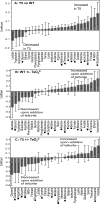Metabolomic investigation of the bacterial response to a metal challenge
- PMID: 19047385
- PMCID: PMC2632130
- DOI: 10.1128/AEM.01771-08
Metabolomic investigation of the bacterial response to a metal challenge
Abstract
Pseudomonas pseudoalcaligenes KF707 is naturally resistant to the toxic metalloid tellurite, but the mechanisms of resistance are not known. In this study we report the isolation of a KF707 mutant (T5) with hyperresistance to tellurite. In order to characterize the bacterial response and the pathways leading to tolerance, we utilized Phenotype MicroArray technology (Biolog) and a metabolomic technique based on nuclear magnetic resonance spectroscopy. The physiological states of KF707 wild-type and T5 cells exposed to tellurite were also compared in terms of viability and reduced thiol content. Our analyses showed an extensive change in metabolism upon the addition of tellurite to KF707 cultures as well as different responses when the wild-type and T5 strains were compared. Even in the absence of tellurite, T5 cells displayed a "poised" physiological status, primed for tellurite exposure and characterized by altered intracellular levels of glutathione, branched-chain amino acids, and betaine, along with increased resistance to other toxic metals and metabolic inhibitors. We conclude that hyperresistance to tellurite in P. pseudoalcaligenes KF707 is correlated with the induction of the oxidative stress response, resistance to membrane perturbation, and reconfiguration of cellular metabolism.
Figures






References
-
- Borsetti, F., A. Toninello, and D. Zannoni. 2003. Tellurite uptake by cells of the facultative phototroph Rhodobacter capsulatus is a delta pH-dependent process. FEBS Lett. 554:315-318. - PubMed
-
- Borsetti, F., V. Tremaroli, F. Michelacci, R. Borghese, C. Winterstein, F. Daldal, and D. Zannoni. 2005. Tellurite effects on Rhodobacter capsulatus cell viability and superoxide dismutase activity under oxidative stress conditions. Res. Microbiol. 156:807-813. - PubMed
Publication types
MeSH terms
Substances
LinkOut - more resources
Full Text Sources
Medical

